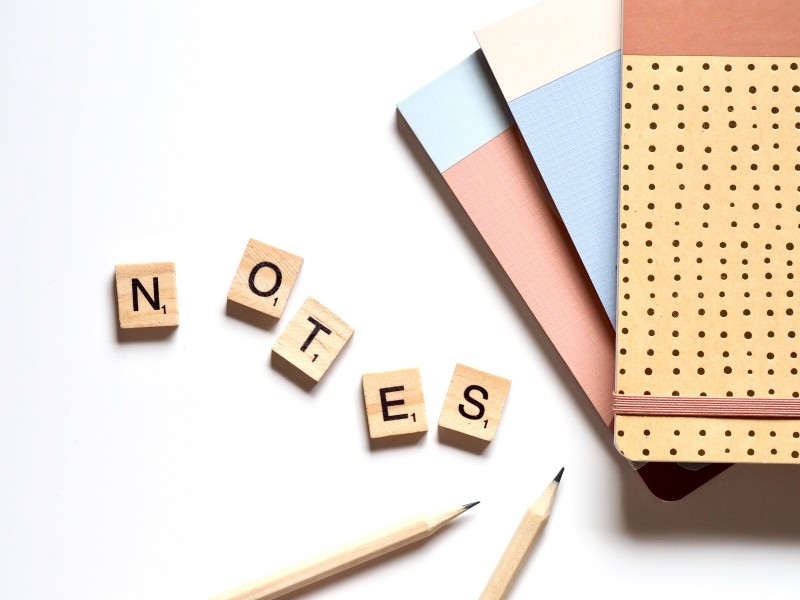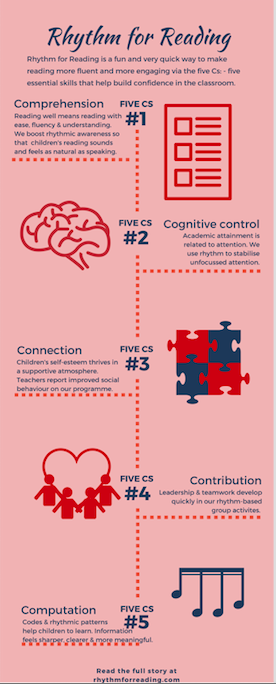The Rhythm for Reading blog
All posts tagged 'reading-fluency'
Fluency, Phonics and Musical Notes
26 September 2022
The phonics wars raged back in the days leading up to the publication of the 2006 Rose Review. The value of synthetic versus analytical phonics was one of the key educational debates of the decade. At that time, the fragile readers that I was working with as part of my PhD, struggled to decode a simple C-V-C word (consonant-vowel-consonant) such as ‘cat’. I was glad that, following the publication of the Rose review all children would be taught systematically to recognise letter-to-sound correspondence, as well as being explicitly taught to recognise the smallest sounds of language. It was unacceptable to me at that time that the phonemes of simple three letter word such as ‘c-a-t’ were a new discovery for vulnerable children at nine years of age.
Below the radar of the mainstream media, music educators were digging deeply into their own entrenched positions around the teaching of musical notation. Unfortunately, these ideologies and their false narratives have limited access to the development of important musical skills and musical knowledge. Decoding musical notes (like any other form of reading) opens up access to participation in a multicultural global community. In the case of music, this community consists of performers, listeners, arrangers, publishers and composers, who engage across ever-expanding musical genres, including sound tracks for video games, film and television. Music educators’ ideologies have limited access to creative opportunities for too long.
Most children start school with thousands of words and hundreds of melodies in their heads. Yet, in schools and music studios, one of the most limiting and perhaps most misunderstood ideologies stemming from high profile music educators, is that of ‘sound before symbol’. Music teachers have been told for decades that best practice involves singing and naming the shapes of tunes using doh, re, mi. Only when the tune has been learned ‘by ear’, are the visual symbols introduced. The idea that a sound must be taught before introducing a symbol to represent it, has a certain logic, but sound does not need to be taught in this way because sound is processed incredibly rapidly in the auditory system and was the first of our sensory processing systems to reach full maturity in utero.
Ofsted’s July 2022 publication supports moving away from the principle of sound before symbol and recommends a stronger commitment to the teaching of musical notation as a part of a broad and balanced curriculum. In the teaching of reading, automated phoneme-to-grapheme correspondence is the key to the rapid development of fluency. Indeed this usually involves presenting the sound with the symbol using rapid response multi-sensory teaching methods. In the Rhythm for Reading programme, we teach sound with symbol correspondence using a rapid response multi-sensory approach to musical notation and therefore prioritise fluency as the overriding goal.
Get in touch by visiting the contacts page if you would like to boost reading fluency in a ten-week period and gain the additional benefit of teaching every child to read musical notation fluently in the very first session of the programme.
Reading fluency and comprehension in 2020
9 November 2020
A strong correlation exists between reading fluency and comprehension - one that has fascinated researchers for many decades (Long, 2014). In our current climate, children who read fluently are more likely to cope well with blended learning, self-isolation and other restrictions of the global pandemic on schools.
How can we move more children into the fluent reader category?
Proficient readers automatically use the most appropriate strategy on the fly, whereas fragile readers are more likely to depend on a single strategy and to transition less efficiently from one strategy to another. A fluent reader however, is able to decode an unfamiliar word using phonological skills, as well as orchestrating contextual and syntactic cues to decode whole phrases.
So, there are many processes that are coordinated during fluent reading. Reading comprehension is a cornerstone of these. However, comprehension is not a ‘layer’ of reading that magically ‘appears’ because it has been mechanically underpinned by good levels of decoding and fluency. Comprehension is a product of rhythmic awareness - an important element of language acquisition in infancy.
Though well-intentioned, the practise of timing children’s reading with a stopwatch, encouraging them to read more quickly week after week is not helpful for cultivating rhythmic awareness. Using a stopwatch may generate a degree of motivation to read, but a focus on acceleration forces the child to read without finding their natural rhythm. In fact, if children have learned to decode at a fast pace, they have been trained to enunciate the words without understanding them at all. Comprehension is not related to the pace of reading.
Comprehension and word recognition are coordinated by rhythmic processes during fluent reading that are similar to the natural unfolding of rhythm during speaking and listening. A rhythm-based approach fosters rhythmic awareness and supports fluent reading.
Long, M. (2014). ‘I can read further and there’s more meaning while I read’: An exploratory study investigating the impact of a rhythm-based music intervention on children’s reading. Research Studies in Music Education, 36(1), 107-124.
Rhythm and Reading Comprehension 1/5
29 April 2018
‘To be understood - as to understand’ from the prayer of St Francis captures a profound truth: we are at our happiest when we feel truly understood by others. This feeling of mutual understanding strengthens communities and generates an aura of certainty at the core of each individual’s character. The ability to understand exists in all of us, but can easily be obscured by doubt, worry or fear. Removing worries, doubts and fears leads to clarity –as Johnny Nash put it, “I can see clearly now the rain has gone…”. The same principle applies to reading comprehension. The songlike qualities of speech (i.e. prosody) come to life in children’s voices when they are able to read with ease, fluency and understanding.
In the Simple View of Reading, reading comprehension is described as the ‘product of’ skilled decoding and linguistic comprehension (Gough & Tumner, 1986). The recent focus on oracy (for example Barton, 2018) highlights a focus in some schools on linguistic comprehension. According to researchers, the proportion of children beginning school with speech, language and communication needs is estimated at between 7 and 20 per cent (McKean, 2017) and unfortunately, communication issues carry a risk of low self-esteem and problems with self-confidence (Dockerall et al., 2017).
In the Gough & Tunmer model, the term ‘product of’ seems a little vague. I like to think that ‘product of’ refers to the flexible quality found in skilled reading as well as the dynamic integration of natural language with the alphabetic code. At first, beginning readers struggle to accommodate words and sentences of a variety of shapes and lengths, but as they become more skilled, they ease into a state of flexible, responsive reading, which leads to being able to read sentences whilst processing meaning at the same time. What is even more remarkable about this process is that reading with this wonderful flexibility takes place within distinct time constraints.
The time constraints are a kind of rhythmic signature for language comprehension as well as music and are biologically determined (Long, 2006). Each and every line of a song, poem or musical phrase typically lasts for 3-5 seconds. This brief ‘window’ is our subjective sense of the present moment (Gerstner & Fazio, 1995). In a song, a poem or a musical phrase, this moment is packed with messages and meanings – relating information about feeling, being or doing. The rhythm of reading in any language is very flexible indeed, but it is underpinned by this constant ebb and flow of units of meaning every 3-5 seconds. Becoming aligned with this natural flow of meaning helps children to read words, phrases and sentences with ease, fluency and understanding and also to anticipate words and phrases prior to reading them.
The importance of this rhythmic ebb and flow of meaning cannot be overstated and is a core part of the Rhythm for Reading programme. The programme uses music rather than words to develop rhythmic sensitivity, so it is suitable for children and young people who need a sharp ‘boost’ in reading comprehension, language and communication skills, phonological awareness or cognitive control, whether attending mainstream or special schools.
Barton, G “Teachers should encourage pupils to speak up – and should remember to do so themselves TES News https://www.tes.com/news/teachers-should-encourage-students-speak-and-remember-do-so-themselves Retrieved on 29.4.2018
Dockrell, Julie Elizabeth, et al. “Children with Speech Language and Communication Needs in England: Challenges for Practice.” Frontiers in Education. Vol. 2. Frontiers, 2017.
Gerstner, Geoffrey E., and Victoria A. Fazio. “Evidence of a universal perceptual unit in mammals.” Ethology 101.2 (1995): 89-100.
Gough, Philip B., and William E. Tunmer. “Decoding, reading, and reading disability.” Remedial and special education 7.1 (1986): 6-10.
Long, M. “Stamping, clapping and chanting: An ancient learning pathway?” Educate Journal, 3, 1, (2006) 11-25
McKean, Cristina, et al. “Language Outcomes at 7 Years: Early Predictors and Co-Occurring Difficulties.” Pediatrics(2017): e20161684.
Catch-Up and Catch-22
14 April 2018
Academic achievement relates strongly and reciprocally to academic self-concept, for example in English and Maths (Schunk & Pajares, 2009) and also reading (Chapman & Tumner, 1995); moreover the importance of motivation increases as perceptions of reading difficulty increase (Klauda et al., 2015). So reading catch-up can also feel as if it’s a catch-22 situation. To resolve this issue, Hattie (2008) recommended that teachers teach self-regulating and self control strategies to students with a weak academic self-concept: ‘address non-supportive self-strategies before attempting to enhance achievement directly’ (Hattie, 2008; p.47).
Peeling back the layers on the self-concept literature, various models and analogies are available (Schunk, 2012). Hattie’s highly effective analogy of a rope captures rather vividly the idea of the congruence of the core self-concept as well as the multidimensionality of intertwining fibres and strands that are accumulated via everyday experiences (2008, p.46). The rope image supports the idea that a particular strand applies to maths, whereas a completely different strand applies to reading and another one for playing football and so on.
The relationship between self-concept and academic achievement is reciprocal (Hattie, 2008) and also specific to each domain (Schunk,2012). Therefore, strengthening self-concept for reading supports achievement in reading, while strengthening self-concept for maths supports maths skills. It is very difficult to strengthen low self-concept in a specific domain before addressing achievement in that area, unless introducing a completely new approach. It is important that the new approach supports self-strategies as well as directly building strength in domain-relevant skills. The Rhythm for Reading programme meets both of these requirements.
Rhythm for Reading works as a catalyst for confidence and reading skills and therefore lifts a negative reciprocal relationship (catch-22 situation) into a positive cycle of confidence and progression. This programme is effective as a reading catch-up intervention because it offers a fresh and dynamic approach, which perfectly complements to traditional methods. Instead of reading letters and words, pupils read simplified musical notation for ten minutes per week. Consequently, they are practising skills in decoding, reading from left-to-right, chunking small units into larger units, maintaining focus and learning, as well as developing confidence, self-regulation and metacognitive strategies all the while.
The musical materials used in the Rhythm for Reading programme have been specially written to be age-appropriate and to secure pupils’ attention, making the effortful part of reading much easier than usual. In fact, throughout the programme, the cognitive load for reading simple music notation is far lighter than for reading printed language, enabling an experience of sustained fluency and deeper engagement to be the main priority. As these case-studies show, this highly-structured approach has had huge successes for low and middle attaining pupils, who were able to read with far greater ease, fluency, confidence and understanding after only 100 minutes (ten minutes per week for ten weeks).
Chapman, J. W., & Tunmer, W. E. (1995). Development of young children’s reading self-concepts: An examination of emerging subcomponents and their relationship with reading achievement. Journal of Educational Psychology, 87, 154–167.
Hattie, J. (1992). Self-concept. Hillsdale, NJ: Erlbaum.
Hattie, John.(2008) Visible Learning: A Synthesis of Over 800 Meta-Analyses Relating to Achievement. Routledge.
Klauda, Susan Lutz, and John T. Guthrie. “Comparing relations of motivation, engagement, and achievement among struggling and advanced adolescent readers.” Reading and writing 28.2 (2015): 239-269.
Pintrich, P.R. and Schunk, D.H. (2002). Motivation in education: Theory research and applications (2nd edition) Upper Saddle River, NJ: Merrill.
Rogers, C.R. (1959). A theory of therapy, personality, inter-relationships as developed in the client-centered-framework. In S. Kock (Ed) Psychology: A study of a science, Vol.3, pp.184-256 New York, McGraw-Hill.
Schunk, D. H. and Pajares, F. (2009). Self-efficacy theory. In K. r. Wentzel & A. Wigfield (Eds.), Handbook of motivation at school (pp. 35-53). New York:Routledge.
Schunk, D.H. (2012) Learning theories: An educational perspective, 6th edition, First published 1991 Boston: Allyn & Bacon, Pearson Education Inc.
Progressive action in schools
25 June 2017
The recent tragic events in London and Manchester have been deeply painful and have also been a sharp reminder of the importance of taking progressive action in education. In 2012, I embarked on an entrepreneurial journey because I wanted the benefits of rhythm-based learning to be available in classrooms everywhere, as well as to ensure that certain educational advantages that are available to the privileged who can afford high quality instrumental music tuition would be, in a condensed and concentrated format, available to all. We hear frequently about the importance of reading for the development of empathy, and in 2014, I decided to create a project which would combine the theme of empathy with rhythm-based activities, which enhance social cohesion, reading fluency, reading comprehension and engagement. With the help and support of the senior leadership teams of two neighbouring, but very different schools, Alleyn’s, an independent school, and Goodrich Community Primary School, we have established a bond based on empathy, cooperation, rhythm and reading.
The project has completed eight cycles so far. Each week a group of assured and enthusiastic Year12 Alleyn’s students have accompanied me to Goodrich School, where they have mentored wonderfully effervescent pupils in Year 3 and Year 4. Everybody benefits profoundly from taking part: the mentoring students quickly learn to build trust and communication with the younger children, who experience a remarkable transformation in their reading. I am very much looking forward to presenting on this topic on Saturday 1st July at the UKLA 53rd International Conference 2017 ‘Language, literacy and class: Connections and contradictions’ at Strathclyde University, Glasgow.
Discover the heartbeat of reading
7 January 2017BETT 2017 is just around the corner! In a few weeks, Rhythm for Reading will be taking part in The Great British Trail in partnership with the Department for International Trade (Stand D30). We will be sharing our ideas and vision with visitors using audio and video clips and other goodies. We’ll be on stand C62 and look forward to saying hello.
The Rhythm for Reading programme helps teachers and students to activate the rhythmic aspect of reading, which researchers are discovering is so important for building reading fluency and understanding.
Why not think of rhythm as the heartbeat of reading?
Just as a heartbeat is dynamic, adjusting to our every need, rhythm in reading is the adjustable quality that provides strength, responsiveness and flexibility as sentences of all shapes and sizes flow through the text.
Just as a heartbeat is organic, supporting life in each part of the body from the smallest cells to the largest organs, rhythm in reading reaches systemically into every part of language. Like a heartbeat it spreads both upwards, supporting the structure of phrases and sentences and also downwards, energising and sharpening the edges of syllables and phonemes. Rhythm therefore brings the different grain sizes of language into alignment with each other.
Sensitivity to the rhythmic cues in printed language can be developed very easily. In fact, we already use rhythm in everyday life to coordinate activities that we take for granted such as walking, talking and obviously, in our breathing. However, as reading is a socially learned activity, the rhythmic quality that is naturally present in language processing does not always map with ease onto decoding skills. This is why for some children reading does not become increasingly skilled over time, even when decoding skills are secure. Fortunately, sensitivity to rhythm in reading can be improved very quickly as these case studies show.
Look out for the next post in this series on rhythm at the heart of reading.

Releasing Resistance to Reading
1 January 2017
It may seem odd to post on the topic of resistance on the first day of the year, but let’s not forget that the flip side of a new resolution involves effort to override old patterns.
Resistance is the entrenched furrow that our everyday thoughts have engraved in our mind. We feel resistance when the initial impetus of the ‘new’ wears off and the familiar old way begins to reassert itself.
This is an uncomfortable topic as resistance is a potentially self-sabotaging behaviour. It has the power to divert our efforts to try new things, unleashing opportunities to face our old fears and stories. It is only when resistance is ‘released’ that the benefits of new behaviours become permanent and lasting change becomes possible.
In fact, some of my most rewarding and meaningful experiences in teaching have involved releasing children’s resistance to reading, teamwork, group teaching, moving in time with others and music. This has happened in a very short timeframe, as part of the process of developing reading fluency through the Rhythm for Reading programme.
Rhythm induces a state of flow and people often talk about getting into a ‘rhythm’ or a ‘groove’ as part of their creative process and also in relation to exercising. Language processing is also sensitive to rhythmic flow states, for example when we become absorbed by a book or when we write and find that the writing starts to flow.
Interviewed about the factors that interfered with flow states, (see last month’s post for more on this) Csikszentmilhalyi’s informants described, ‘aspects of normative life’ which included: a sense of unmanageable fear, the pressure to work to deadlines and clock-watching. There was a general orientation towards the final outcome rather than the process - in other words, the journey. A focus on extrinsic rewards and material gain and also social rewards also seemed to block people’s ability to find flow, which tells us something about effects of consumer culture of that time. Even at the turn of the century there was an awareness that becoming mentally distracted was a growing problem and people also reported a confusion of attention. Lastly, isolation from nature was described as a big factor in people’s loss of flow. Thankfully, almost twenty years later, we are now more aware of the therapeutic value of spending time in nature..
From this list, it seems that the conditions of contemporary life may not only impede the development of flow states, but also reinforce the experience of resistance. Many of the items on this list pop up in our homes, places of work, schools and classrooms. As we move forward into 2017, perhaps, a fresh look at our everyday lives could help us to find and maintain flow states and make time for opportunities to gently release resistance.
Csikszentmihalyi: (1975; 2000) Beyond boredom and anxiety: Experiencing flow in work and play, 25th anniversary edition San Francisco, Jossey-Bass Inc.
Reading fluency again - looking at prosody
1 October 2016In this second blog post in my series on reading fluency, I am looking at prosody. At the end of the Rhythm for Reading P[rogramme, teachers often say that there has been a distinct improvement in the prosodic element of children’s reading. Prosody is closely associated with skilled reading, being integral to fluency and a predictor of achievement in reading accuracy and comprehension (Veenendaal et al., 2016). Prosody is not taught, but it is a naturally occurring feature of competent reading. The words on the page may be arranged in horizontal lines, but a good reader transcends the visual appearance of the words, allowing them to take on a natural, flexible and speech-like quality.
Perhaps good readers could be compared to good tennis players in the sense that they can respond intuitively, flexibly and rapidly to the dynamic, fast-moving pace of change, whether on the court, or on the page. Imagine you are watching a tennis rally. Every time the players hit the tennis ball, it carves a unique trajectory through the air. Often, the players may return the strokes in the manner of reciprocation, but sometimes the trajectory may surprise or challenge a player, requiring them to respond with renewed agility if they are to regain their poise.
Poise is also required in reading and researchers have asked how good readers are able to rapidly integrate the elements of reading, given that the processing areas of the brain known to be involved in the decoding and understanding of printed language, are not local to one other (Rayner, Pollatsek, Ashby, & Clifton, 2012). It is possible that just as good tennis players are able to predict their opponent’s next stroke, good readers are able to predict the most likely contour in terms of sentence structure, and anticipate the most meaningful content in relation to contextual cues, thus integrating the various processes of reading.
The rhythmic elements of integrated processes are perhaps more apparent in a tennis match than in reading. The elasticity and subtle shifts in the rhythm of a tennis rally can electrify a crowd. Each stroke is not a mere repetition of the previous stroke – it is a renewal of the previous stroke and as such, is inherently rewarding to the player and the audience. Similarly, as a reader confirms the meaningful aspect of one sentence and projects the probable meaning(s) at the beginning of the next sentence, a natural cycle of projection and renewal of understanding develops.
References
Rayner, K., Pollatsek, A., Ashby, J., & Clifton, C. Jr., (2012). Psychology of reading (2nd ed.). New York: Psychology Press.
Veenendaal, N.J., Groen, M.A. and Verhoeven, L., 2016. Bidirectional relations between text reading prosody and reading comprehension in the upper primary school grades: a longitudinal perspective. Scientific Studies of Reading, 20(3), pp.189-202.
